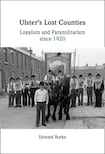
These are the shadowlands, the three Ulster counties of Donegal, Cavan and Monaghan not in Northern Ireland, their unionist and Protestant inhabitants marooned tantalisingly “outside the glow” after 1920. This was an angry peoplehood, abandoned by their fellow Ulster loyalists who were prepared to jettison them in pursuit of a more defensible statelet. In the new Irish Free State, they were treated with considerable hostility and suspicion. They were, in Hubert Butler’s phrase about southern Protestants, “nobody’s children”.
Edward Burke is assistant professor in the history of warfare at University College Dublin, and therefore it is no particular surprise to find that the focus of this comprehensively researched, if eye-wateringly expensive, book is largely on militant politics and armed loyalist resistance on both sides of the Border. He does not pretend to represent the wider experiences of Protestants in the three counties, including those who, outwardly at any rate, accepted the new state. Burke is too modest in that regard; there is quite a lot of contextual analysis around the part these Protestants played in the local and national politics of independent Ireland.
He argues that memories of violence “entrenched a sense of separation from the new Irish State on the part of subsequent generations”. This led to involvement in loyalist paramilitary activities during the Troubles of 1968-1997. He also avers that Monaghan loyalists in particular played an important role in countering IRA violence during the War of Independence.
What is it about this area that marks its unionism and Protestantism out from the rest of independent Ireland? Burke suggests that it is a specifically Ulster loyalism that provides the pull — “a community or culture defined by narratives of Protestant settlement, struggle and heritage in Ireland’s northern province, and fealty to a wider British identity”. Maybe — but that could also be applied to much of the rest of Protestant Ireland as it tried to come to terms with being beached on the wrong side of a revolution after 1922. The difference was that these counties formed a frontier territory, a perilous, porous Border that, through its sheer existence, was contested — always defended by one community, delegitimised by the other.
A further mystery is this: if the Irish Free State was such an appalling place (and Burke adduces plenty of bitter complainants who averred that it was), why did so many of these disaffected and alienated loyalists remain? There may have been a host of reasons, ranging from economic necessity to family and community ties. Many did leave, of course. Yet maybe the whole apparatus of existence and coexistence had, by the late 1960s, reached a sort of equilibrium, a type of stasis that was bearable for unionists — and nationalists. Where there was conflict, it often seemed ritualised — and ritual is a way of dealing with uncomfortable situations. If each side understands what to do, and react to, in any given situation, tensions can be managed.
What marks out loyalism in these counties from the rest of “the South” is its participation in violent resistance during the War of Independence. Here Burke argues that Monaghan loyalists were active and successful against suspected republicans in 1921, whereas in Cavan armed resistance was less intense and poorly organised. Pettigo in Donegal was a flashpoint between the IRA, local loyalists, the Ulster Special Constabulary and the British and Irish armies in June 1922.
The book also takes an original and timely look at how these Border loyalists affected events north of that Border, including their influence on Northern Ireland’s security forces, militant movements there since partition and their involvement in paramilitary organisations during the later Troubles.
A final chapter examines some case studies from the 1970s, such as the murder of Senator Billy Fox in 1974, the service of those from the three counties in the UK military and police, the championing by the Orange Order in Northern Ireland of their brethren in the three counties, and the intrigues of spies and informers — all in the context of renewed suspicions about the allegiances of these Border Protestants.
Through the churches and particularly the Orange Order, Border Protestants had a support network of depth and breadth that was largely Border-blind, and which was unavailable to other southern Protestants — the Orange Order had vanished from the rest of independent Ireland long before the 1970s.
One of this book’s strengths is its clever and thoughtful evocation of the atmosphere of border loyalist “belongingness”. It is perhaps regretful that the identities of these Protestants are not more deeply interrogated by counterpointing their fears, hopes, experiences, actions with how Protestants in the rest of the Free State and Republic reached their accommodation with a polity of national Catholicism in which, for a long time, they were uneasy.
Nora Robertson suggested in 1960 that this was partly achieved by an ability to wear two hats — “In respecting new loyalties it had not seemed incumbent upon us to throw our old ones overboard”. By 1995 Church of Ireland Archbishop Caird of Dublin could proclaim that the southern Protestant community in the Republic was “a confident minority well understood and well accepted”. Such dualism allowed it to move gradually but decisively from clinging to the apron strings of a British loyalism to largely throwing its lot in with the Irish patria.
Burke implies that residual loyalism in the “lost” counties has exhibited a longer finish than elsewhere in the Republic, evidenced by the example of the celebration in Cavan of the coronation of Elizabeth II in 1953. But it is worth noting that in 1952 in the deep South, a service was held in Cork’s St Fin Barre’s Church of Ireland cathedral to mark the death of her predecessor George VI; and the pupils of the Anglican-sponsored Cork Grammar School were gathered compulsorily to listen to a radio broadcast of the new Queen’s crowning. Things are seldom simple or linear in Ireland.
Border loyalism has had a slow, fractured journey, to which this insightful book attests. Even if Burke concludes that “an affinity to a loyal, Ulster identity” in the Republic has waned considerably, what emerges is a sort of frustrated nostalgic sadness from these stranded communities and families, a reluctance — and a sort of inability — to let go.
What perhaps unsettled them was their maddening closeness to a Border beyond which many thought were the sunlit uplands, always just out of reach. Hanging over the fence, they desperately desired to join the action on the other side. But they could only be peripheral players. Possibly, that may be the fate of all frontier communities; the three “lost” counties of Ulster illustrate that truth.














